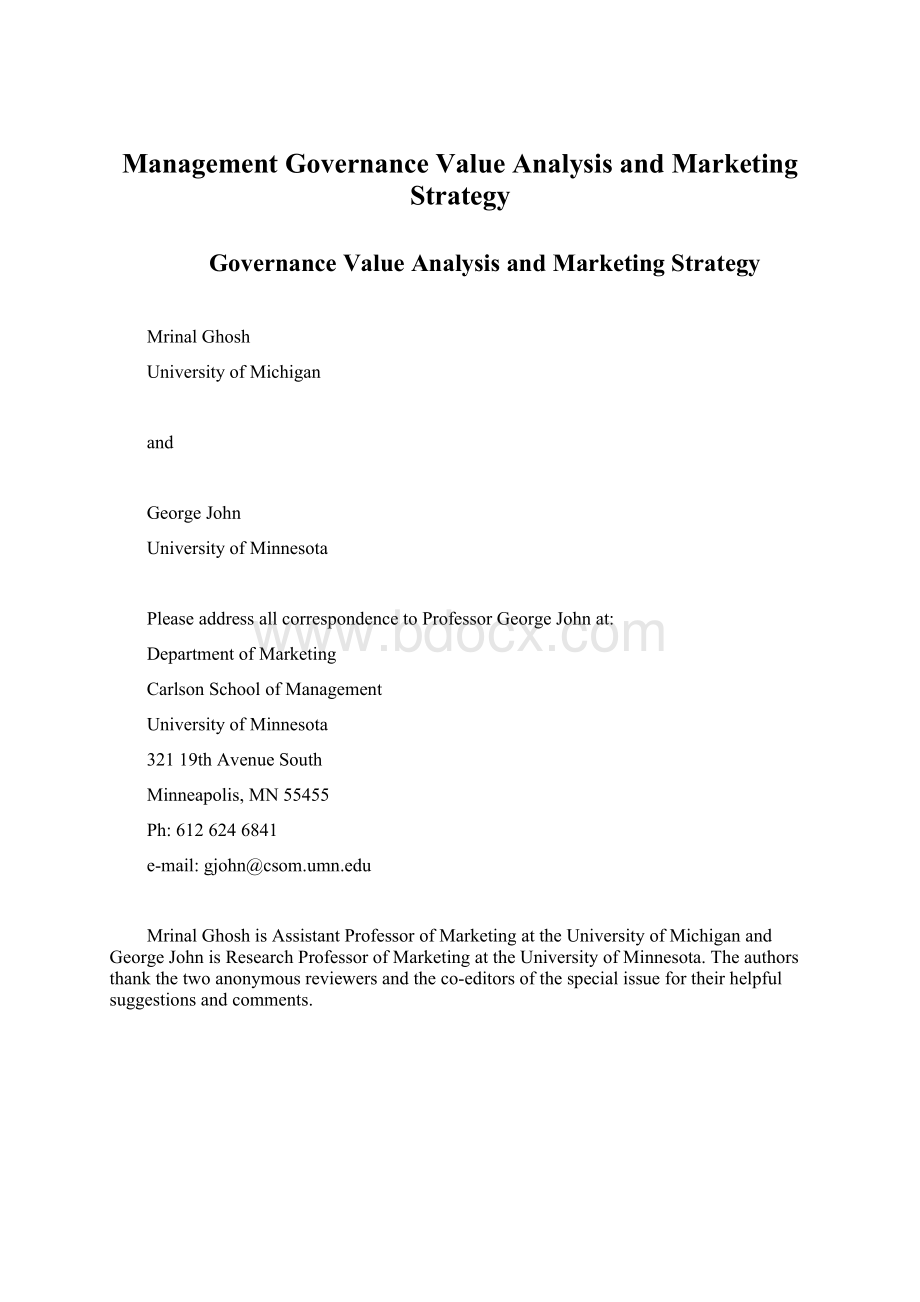ManagementGovernance Value Analysis and Marketing Strategy.docx
《ManagementGovernance Value Analysis and Marketing Strategy.docx》由会员分享,可在线阅读,更多相关《ManagementGovernance Value Analysis and Marketing Strategy.docx(26页珍藏版)》请在冰豆网上搜索。

ManagementGovernanceValueAnalysisandMarketingStrategy
GovernanceValueAnalysisandMarketingStrategy
MrinalGhosh
UniversityofMichigan
and
GeorgeJohn
UniversityofMinnesota
PleaseaddressallcorrespondencetoProfessorGeorgeJohnat:
DepartmentofMarketing
CarlsonSchoolofManagement
UniversityofMinnesota
32119thAvenueSouth
Minneapolis,MN55455
Ph:
6126246841
e-mail:
gjohn@csom.umn.edu
MrinalGhoshisAssistantProfessorofMarketingattheUniversityofMichiganandGeorgeJohnisResearchProfessorofMarketingattheUniversityofMinnesota.Theauthorsthankthetwoanonymousreviewersandtheco-editorsofthespecialissuefortheirhelpfulsuggestionsandcomments.
GovernanceValueAnalysisandmarketingstrategy
Abstract
Weextendtransactioncostanalysis(TCA)intoagovernancevalueanalysis(GVA)frameworkthatextendsthecoreTCAmodeltoaddressmarketingstrategydecisions,especiallywithregardtostrategiesgroundedincooperativerelationships.Toaccomplishthis,weincorporateresourceheterogeneityfromtheresource-basedviewsofstrategy.Wedevelopafour-partmodel.Thecreationandclaimingofvalueareitstwofundamentalprocesses.Weshowthatheterogeneousresources,positioning,theconsequentattributesofexchange,andgovernanceformallinteracttodeterminesuccess.GVAdisclosesthetradeoffsbetweenthesefactors.ThesetradeoffsconstitutethecoreoftheGVAframework.Weillustratesupportforthesetradeoffswithexamples,andspecifyrefutableimplicationswhereverpossible.Finally,wesketchdirectionsforfuturework,andprovideablueprintforimprovingmanagerialdecision-makingbasedontheGVAmodel.
Introduction
Transactioncosteconomicshasbecomethedominantparadigmforanalyzingissuesinseveralareasofmarketing,includinginter-firmrelationships,channelstructure,foreignmarketentryandthelike.Alargenumberofempiricalstudiescorroboratetheprincipalrefutablepredictionsconnectingtransactionattributeslikespecificinvestments,uncertaintyandperformanceambiguitytogovernanceformslikeverticalintegration,andalliances(seeRindfleischandHeide,1997forareviewofTCAworkinmarketing).Despitethesesuccesses,TCAhasmadelittleheadwayintothemarketingstrategyliterature(anearlyexceptionisDayandKlein,1987).Indeed,someofthesharpestcriticismofTCAhasemergedfromthestrategy-orientedwork,andtheyconvergeoncommonthemes.
OnestrandcontendsthatTCAisamerecostminimizationcalculusbasedonexogenousattributesofanexchange,andassuch,itprovideslittleinsightintostrategicmarketingchoicesthataregroundedinfirm-specificdifferences.Hence,HuntandMorgan(1995)chargethatTCAessentiallypredictsthatallcompetingfirmsinamarketwillchooseidenticalgovernanceforms(likeverticalintegration)astheyallfacethesameleveloftheexogenousattributesimplicatedinthetheory.Yet,casualobservationshowsthatcompetingfirmsinthesameproductmarketdemonstratestarkdifferencesinundertakingsimilaractivities.Forinstance,intheretailhardwareindustry,DwyerandOh(1988)findthatretailersusingdifferentdownstreampositioningstrategiesexhibitsystematicdifferencesinupstreamchannelstructures.Whydofirmsoperatinginthesameindustrydemonstratesuchsharpdifferences?
Clearly,thecurrentframeworkisunsatisfactoryinthisregard.
AsecondstrandchargesthatTCA'ssingle-mindedfocusoncostminimizationprovideslittleinsightintostrategicmarketingchoicesthatareundertakenprincipallytoenhanceand/orclaimvalue(ZajacandOlsen,1993).Thisisanalogoustotheeffectivenessvs.efficiencydebatefoundinorganizationaltheory.Surely,alternativesthataremoreeffective(inthesenseofincreasingprofits)couldbeattractivedespiteconcomitantlossesinefficiency.Aclassiccasewouldbeexpenditurestoraiseentrybarrierseveniftheadditionalcostsmeantthatsomemarginallowcostproductshavetobesacrificed.Theseobservationsprovokethequestion:
Howdostrategicfactorslikepositioningandresourcedifferencesinfluencethedesignofsupplychainandendcustomergovernanceforms?
Onoccasion,thesestrandsarejoinedtorejectanybenefitwhatsoevertopracticingmanagerstobederivedfromTCA(e.g.,GhoshalandMoran,1996).Whenthesecritiquesarejuxtaposedagainstthelengtheningnumberofempiricalstudiesthatlargelycorroboratethecorerefutableimplicationsfromthetheory,itsuggeststhatsomeclarificationandexpansionoftheapproachisinorderatthispoint.
PurposeofPaper
WeproposearevisionandexpansionofthebasicTCAmodeltoenableittospeakmorecloselytomarketingstrategydecisions.Todistinguishourvariant,welabelitGovernanceValueAnalysis(GVA)inthespiritoftheZajacandOlsen(1993)label,"TransactionValueAnalysis".Wegiveequalemphasistoboththerevenueenhancingaswellascostreducingfeaturesofgovernancedecisions.Weincorporateheterogeneityfromtheresource-basedview(RBV)ofstrategy(Peteraf,1993)andaccommodatepath-dependentinfluences(Ghemawat,1991).DayandKlein(1987)offeredthefirststepinthisdirectionofintegratingstrategyandtransactioncostanalysis.Webuildontheirstartandcapitalizeonrecentconceptualadvancesandempiricalobservationstosupportelementsofourframework.
MARKETINGStrategyFROMAGOVERNANCELENS
TheoreticalfoundationsofTransactionCostAnalysis
Transactioncostsassociatedwitheconomicexchangeincludeexanteandexpostcosts.Exantecostsaretheoutofpocketcostsofnegotiatingcontracts("ink"costs)andtheopportunitycostofforegonetransactions.Expostcostsaretheoutofpocketcostsofmonitoringandenforcementagreements,andtheopportunitycostsofnotshiftingtomoreprofitableactivities(RindfleischandHeide,1997).
Howarethesecostsrelevanttomarketingstrategydecisions?
WeturntoWilliamson(1996)whoobservesthatTCAcanbecompactlysummarizedasunpackingtheramificationsoftheCoase"theorem".Accordingly,intheabsenceoftransactioncosts,partiestoanexchangedevisejointprofitmaximizingexchangesregardlessoftheirpowerdifferentialsorresourceendowments.Ofcourse,transactioncostsarenotzerointherealworld.Givenpositivetransactioncosts,thecoreprincipleofTCAisthatpartieswillstrivetoaligngovernanceformswithexchangeattributessoastominimizethetransactioncostsofexchange.Why?
Suchanalignmentgetsthemclosertobeingabletoaccomplishthedesiredgoalofjointprofitmaximization.Noticethelogicconnectingminimizationoftransactioncostswiththemaximizationofjointprofits.TCA'srefutablepredictionsfollowfromthissimplelogic.
Hence,theessentialcriterionforassessingtheefficiencyofamarketingsystemisthejointbenefitstreamthatcanbegeneratedwithinthatsystemofinter-relationships.Webelievethismetricismoreappropriatethantraditionalcriterialikeindividualfirmprofitsordecision-makerutilitybecauseitexplicitlytakesintoconsiderationtheinterestsofalltheplayersinvolvedinaparticularsystemofinter-relationships,includingthefirm,itssuppliers,itscustomers,anditscompetitors.Wernerfelt(1994)illustratesthewide-rangingutilityofthisprincipleinhis"efficiency"approachtodesigningmarketingsystems.Tobeconsistentwithexistingresearch(e.g.,BrandenburgerandNalebuff,1997),wecallthisjointbenefitstreamasvalue.
RelationshiptoOtherStrategyModels
Contemporarystrategymodelsarecoalescingaroundthecoreprocessesofvaluecreationandclaiming.Toseethis,considerabriefoverviewofprominentmodelsofstrategy.Ghemawat(1991)firstintroducedcreationandclaimingofvalueasthetwofundamentalprocessesthatarenecessaryandsufficienttounderstandstrategy.Creationofvalueisachievedthroughfavorablepositionsthatarecommitment-intensive.Commitmentintensivepositionsare"sticky"choicesinthesensethattheyinvolveinvestingindurableandspecializedassetsthatarenoteasilytradeableinopenmarkets.Theyhenceintroducelock-ineffectsandincreaseswitchingcosts.Claimingthevaluegeneratedfromtheseprospectivelyfavorablepositionsrestsonthese"sticky"factorsbeingscarceandappropriabletoitsowners.
Theresource-basedview(RBV)ofstrategy(e.g.,Peteraf,1993)makesaverysimilarargument.IttakesaRicardianviewofcompetitionwhereingreaterprofitflowtotheholdersofsuperiorproductivefactors.ConsiderasimplestylizedexampleofRicardiancompetition.Supposethatnfirmscompeteinacommoditymarket.Furthersupposethateachfirmpossessesadifferentsetofassets/skillsandisthusabletoproduce(i.e.,createvalue)atadifferentcost(includingcostofcapital).Denotethesecostsas1,2...nfromsmallesttolargest.Game-theoreticmodelingrevealsamarket-clearingpriceof2(thesecond-lowestcost).Firm1enjoysaneconomicprofitequaltothedifferencebetweenthetwolowestcosts.Firm2willmakeareturnjustenoughtocoveritscostofcapital.Allotherfirmswillbeunprofitable.
ObservethedifferencebetweenRBVandthecoreroleofmarketpowerembeddedinPorter'searlierfive-forcestrategymodel.RBVinvokesanefficiencyviewofstrategy.Firm1'sprofitsderivefromitsuniqueskillsandassets.Allthefirmsinourstylizedcommoditymarketbehavefullycompetitively,yetprofitdifferencesoccurandpersist.Ofcourse,iftheskilldifferencebetweenFirm1anditsnearestcompetitorerodes,thenpricesfall,andthecreatedvalueisnotclaimed.
Thiscanbeextendedtomorerealisticmarketswithdifferentiatedproductswithnolossininsight.Ricardianprofi